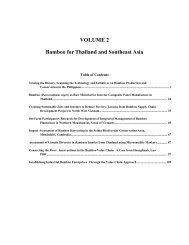WBC-VIII-Vol.4 – Resources – Forestry, Plantations and ... - BambuSC
WBC-VIII-Vol.4 – Resources – Forestry, Plantations and ... - BambuSC
WBC-VIII-Vol.4 – Resources – Forestry, Plantations and ... - BambuSC
You also want an ePaper? Increase the reach of your titles
YUMPU automatically turns print PDFs into web optimized ePapers that Google loves.
Planning, Designing <strong>and</strong> Implementing a Jati Bamboo<br />
(Bambusa tulda) Plantation Scheme through Bank Credit<br />
on Small L<strong>and</strong>holder’s Revenue Wastel<strong>and</strong>s in Assam, India<br />
for Sustainable Livelihood<br />
Abstract<br />
M.S.Haque <strong>and</strong> K.G.Karmakar<br />
General Manager <strong>and</strong> Managing Director<br />
National Bank for Agriculture <strong>and</strong> Rural Development (NABARD), B<strong>and</strong>ra east, Mumbai, Maharashtra, India<br />
National Bank for Agriculture <strong>and</strong> Rural Development (NABARD) is a developmental bank <strong>and</strong> provides credit<br />
for promoting sustainable agriculture including bamboo cultivation.Hindustan Paper Corporation in Assam uses<br />
bamboo as raw materials but faces difficulties in procuring bamboo from forests due to inaccessibility, hence<br />
desired seedling based bamboo cultivation under farm forestry <strong>and</strong> approached NABARD for suitable credit<br />
schemes for small l<strong>and</strong> holders. Accordingly it prepared a scheme for raising seedling based Dendrocalamus<br />
strictus plantations. However, the farmers were not interested to raise bamboo through seedlings, rather they<br />
requested NABARD for Bambusa tulda cultivation scheme through rhizomes. After undertaking field visits,<br />
holding workshops with NGOs, farmers <strong>and</strong> bankers, a rhizome based scheme for intensive cultivation of<br />
bamboo was formulated for the districts of Assam. The scheme was exclusively designed for farmers who<br />
could spare at least one bigha ( 1 / 3 acre) of wastel<strong>and</strong>s <strong>and</strong> the cost of cultivation was Rs. 9050 over a<br />
period of 4 years (1 US$=INR 50). 85 bamboo rhizomes were planted per bigha with spacing of 4 m x 4 m <strong>and</strong><br />
in every alternate year 40 clumps would be harvested annually from 5 th year onwards. Based on an average<br />
price of Rs. 20 per bamboo, income would be Rs. 6400 in 5 th year, reaching to Rs. 16,000 in 10 th year on retail<br />
sale . The interest charged on loan by bank was 8% per annum <strong>and</strong> IRR of the scheme was 37%.<br />
Implementation of the scheme started during 2006-07 <strong>and</strong> more than 100 farmers were provided loans by<br />
Assam Gramin Vikas Bank. Repayment of loan with interest would be completed within 8 years. The financial<br />
outlay of the scheme was Rs. 48.86 million for developing 1800 acres of small farmer’s wastel<strong>and</strong>s. The<br />
scheme can be replicated in other districts of Assam.<br />
Keywords: Bamboo, small l<strong>and</strong>holders, credit, sustainable livelihood<br />
Introduction<br />
NABARD is a national level institution for providing <strong>and</strong> regulating credit <strong>and</strong> other facilities for the promotion<br />
<strong>and</strong> development of agriculture, small scale industries, cottage <strong>and</strong> village industries, h<strong>and</strong>icrafts <strong>and</strong> other<br />
allied economic activities in rural areas. It is responsible for supervision of rural co-operative credit structure<br />
<strong>VIII</strong> World Bamboo Congress Proceedings Vol 4-2




